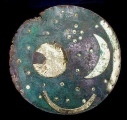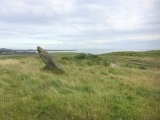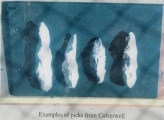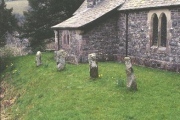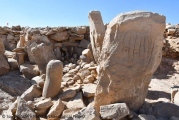Andy Burnham's Blog, page 147
March 7, 2022
Proleek Dolmen
New ideas on dolmens, in conversation with Vicki Cummings and Colin Richards - video and book available now, see the latest comment on our page. Approached via Ballymascanlon House Hotel, and on foot through the stableyard, following the signs, this fine dolmen in Co. Louth has a huge 40-tonne capstone balanced on two portal-stones over 2.1 metres high and a backstone 1.8 metres high. There may not have been other stones to complete the chamber.
Published on March 07, 2022 06:23
March 6, 2022
Arche Nebra
Concepts of Cosmos in the World of Stonehenge, two talks from the British Museum on video, first Prof Harald Meller on the Nebra sun disc, after that Prof Tim Darvill presents his Keeping time / numerology at Stonehenge idea which has recently been published in Antiquity, more in the comments on our page. The Arche Nebra is a visitor centre at the site of the discovery of the Nebra sky disc The varied, multimedia presentation in the interior of an architecturally extraordinary building tells the fascinating story of the heavenly disc, which was found in 1999.
Published on March 06, 2022 08:22
March 5, 2022
Llwyn y Crair Sphynx
When I offer a post of a natural feature it's because I consider it to have character, something that makes it a little special, eg. it also stands out to others due to its oddity or circumstance. It's also a bonus if there's a bit of history or a back story attached. This feature always raises a smile when I pass by.
Published on March 05, 2022 06:35
March 3, 2022
Torradale Standing Stone
A leaning 5 foot+ (1.5m+) standing stone on the Isle of Islay which was probably part of the ruined chambered tomb which it is right beside. The site was reclassified as a Chambered Cairn after a visit by the RCAHMS (now Historic Environment Scotland) in 2006. The field notes from the 2006 visit give extensive measurements of the ruined cairn and details of its history. See further down our page for the link
Published on March 03, 2022 09:22
March 1, 2022
Culverwell Mesolithic Site
Sadly Culverwell mesolithic site, one of the few it was possible to visit, is due to be backfilled to preserve it from further erosion and animal damage, more in the comments on our page. Mesolithic Settlement on Portland Bill in Dorset. The main feature on this site is a large floor of limestone slabs on top of a shell midden (rubbish dump). This floor is the earliest known structural evidence in England for the extensive use of Portland Jurassic limestone on a living site.
Published on March 01, 2022 06:59
February 28, 2022
Charkadio Cave
This cave is located in the centre of the Greek island of Tilos. During excavations carried out by the Museum of Geology and Palaeontology of the University of Athens in collaboration with the Natural History Museum of Vienna, 15,000 bones were found from 40 dwarf elephants that were 120 - 150 cm high and belonged to the species Palaeoloxodon tiliensis.
Published on February 28, 2022 12:31
Yuzhnoukrainsk Cromlech
In solidarity with Ukraine. The Yuzhnoukrainsk Cromlech (Южнобужский кромлех) in southern Ukraine looks like a round barrow with kerb stones or a chambered cairn. On an area of about 100 square meters, twelve rings made of stone were found, thought to date to the middle Neolithic. Its entire form is made of stone hidden under a layer of soil apart from the visible stones sticking out, Thanks to this its shape has been well preserved, the spiral corridor inside was once perfectly visible. According to stories of the old-timers, there used to be rumours that once there was a large stone or an idol in the center of the cromlech.
Published on February 28, 2022 03:01
February 27, 2022
Gwytherin Churchyard
In this ancient circular churchyard in Clwyd stand a row of four small stones aligned east-west. They are about 3m apart from each other, and one bears a Latin inscription of a style dated to the 5th or 6th century AD. Some authors believe the stones to have been erected in this early Christian period. Others, however argue the row to be much more ancient in origin, with the inscription being re-use of a Bronze Age row as a personal memorial. Janet Bord contacted us to say she thinks the stones were placed in this position in the early 18th century, more details in the comments below.
Published on February 27, 2022 02:21
February 26, 2022
Northern Earth Issue 167 Out Now
In this issue: Stones of Arabia - Standing stones are being re-erected as waymarkers across a desert to honour an ancient sacred trail
From Russia with Malice - The prehistory of Russian hacking paranoia? David Taylor summarises a bygone suspicion of leys as threats to national security
Follow her forward, the innocent hare - Its spring, and the hare is part of its magic, as John Billingsley relates in a tribute to its extraordinary presence
A new dimension to ancient measures - Peter Harris describes further research on the Harris-Stockdale Megalithic Foot
The Angell of England and Great-Nephew to the Queen of Faerie - Its the 17th century, and in Lancashire new Protestants are tinged with extraordinary inspiration.
Mark Valentine remembers the Grindletonians
From Russia with Malice - The prehistory of Russian hacking paranoia? David Taylor summarises a bygone suspicion of leys as threats to national security
Follow her forward, the innocent hare - Its spring, and the hare is part of its magic, as John Billingsley relates in a tribute to its extraordinary presence
A new dimension to ancient measures - Peter Harris describes further research on the Harris-Stockdale Megalithic Foot
The Angell of England and Great-Nephew to the Queen of Faerie - Its the 17th century, and in Lancashire new Protestants are tinged with extraordinary inspiration.
Mark Valentine remembers the Grindletonians
Published on February 26, 2022 08:56
February 25, 2022
Jibal al-Khashabiyeh
Major discovery of a unique ritual installation of the "Ghassanians" gazelle mass hunters. Several "desert kite" hunting trap features dating from the Pre-Pottery Neolithic, 7000 BCE, with recently discovered ritual stone settings which include two standing steles with anthropomorphic features. The tallest of the two (ca. 1.12 m high) also bears a depiction of a "Desert kite" intermingled with the human figure. The second standing stone (ca. 70 cm high) exhibits a human figure with finely carved details.The various finds, in addition to a ritual altar stone associated to a hearth, were organized within a reduced model of desert kite, built with stones in the middle of the campsite. This is the only architectural model of its kind known to date in a Neolithic context anywhere in the world.
Published on February 25, 2022 11:38


